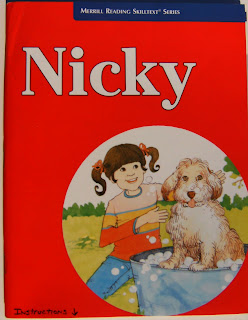Abaci were developed in a period when commerce was common, but paper was too rare and expensive to jot down the numbers of the addition and multiplication problems needed for transactions. The abacus allowed you to "write" out the problem and solve it a little bit at a time without the use of paper.
It is useful as a tool for engaging the child's mind while practicing simple addition and multiplication.
Our abacus, is actually a "soroban" which is a japanese variety with 1:4 bead ratio.

Each vertical wooden post has 4 lower beads each signifying 1(or 10, 100,1000 etc), and one upper bead signifying 5(or 50, 500, 5000 etc). Each succeeding post signifies 1's, 10's, 100's, etc just as if writing a number. Numbers are signified by the beads resting against the middle bar.
To signify zero, the lower beads rest down on the lower bar and the upper bead rests against the upper bar. For numbers 1-4, you move 1-4 of the lower beads upward.
Five is shown by all the lower beads resting down and the upper bead moved down to rest on the middle bar. Numbers 6-9 then add lower beads to the "5" bead. To count "10", you move all the beads on the "ones" post back to the "zero" positions and move one of the "tens" beads up to the middle bar.
Ten through ninety is just like 1-9, except it is on the 10's post instead of the 1's post.
The orange beads along the bottom of the frame are used to signify the "ones" post for up to three different numbers. The post the bead is placed below now signifies the "ones" place of a number.
Using the three little orange balls that move along the lower bar, you can set up a problem like 37 x 44 =?. The rightmost column will have an orange ball below with "7"(red moved down=5 and two lower beads moved upward=2//5+2=7). the next column will have 3 of the lower beads moved up for "30"(10+10+10 in the "tens" space=30) ; thus "37". The third bar will have an orange bead below the post with 4 beads moved upward(=4)above; the fourth bar will have 4 beads moved up as well(=40), thus "44". The fifth bar will have the last orange bead below signifying the "ones" column of the answer.
To calculate the answer you multiply each column in turn using the white beads above to help you keep track of your place results as you multiply each part of each number. I will make a video called "soroban multiplication" showing how to use this later this year and post it in the right hand column under videos.
In the mean time, you can view the YouTube videos in the right column or visit the weblinks below by copy/pasting them into your browser address bar. I don't know why the hyperlinks didn't work.
Once a child is good at multiplying using the abacus and on paper, they are ready to try multiplying in their head alone--using their own short term memory to hold places and add numbers without the aid of the abacus. To figure out 7x14 in your head, you need to know your multiplication tables and be good at adding too. You have to hold 7, 14, 28, 70, and 98 in your head and manipulate them. 27 x14 in our head would entail 27,14, 28, 80, 104, 70,200,270, and 374. Hopefully, all the kids will get there some day.
abacus links:
http://en.wikibooks.org/wiki/Using_an_Abacus
http://www.soroban.com/howto_eng.html
http://webhome.idirect.com/~totton/abacus/pages.htm
http://www.globalsoroban.org/english.html
http://en.wikipedia.org/wiki/Soroban
http://www.typoscriptics.de/soroban/links.html

























